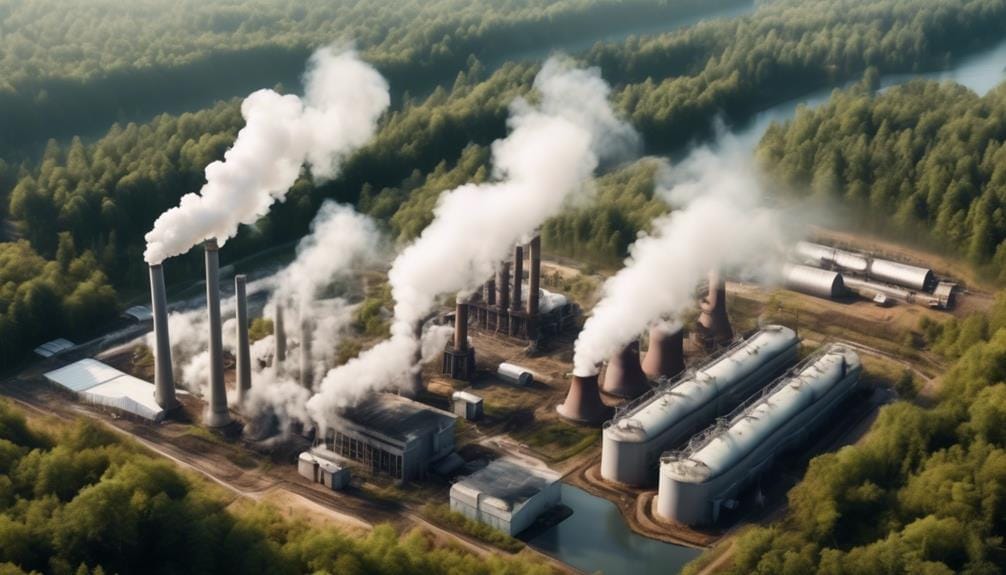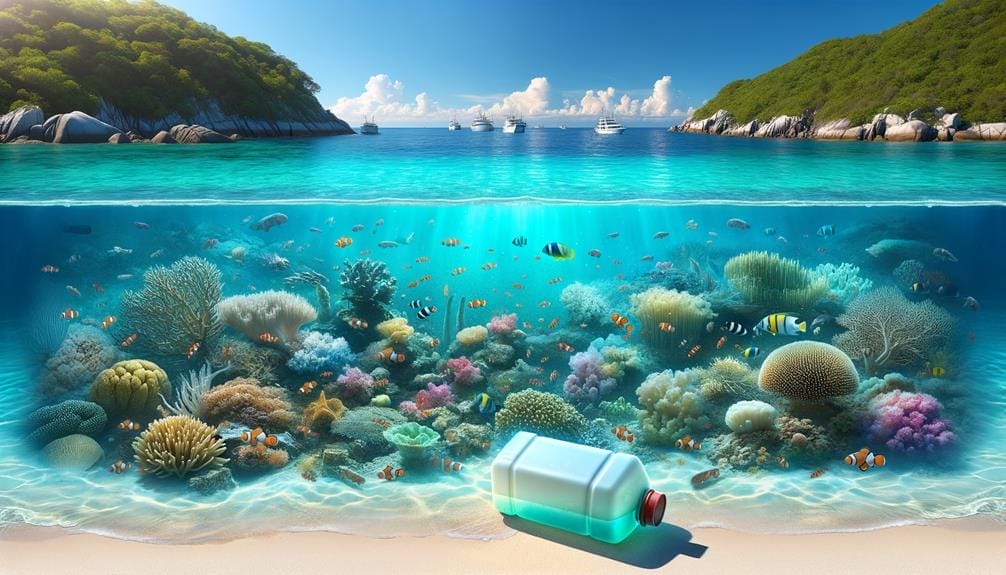Have you ever wondered about the environmental impact of epoxy resin?
It is often used in various industries and DIY projects due to its versatility and durability.
However, there is a growing concern about the potential harm it may cause to the environment.
Is the theory true that epoxy resin has a significant environmental impact?
In this discussion, we will explore the production process, disposal methods, long-term consequences, and alternative eco-friendly materials related to epoxy resin.
Stay tuned to learn more about the potential environmental implications and how we can mitigate them.
Key Takeaways
- Epoxy resin production and use heavily rely on fossil fuels, contributing to resource depletion and environmental pollution.
- Improper disposal of epoxy resin can have negative environmental implications, including leaching of petrochemicals and risks associated with synthetic epoxy resin in landfills.
- Sustainable disposal practices, such as proper waste management options and chemical recycling efforts, are crucial to minimize the environmental impact of epoxy resin.
- Long-term consequences of epoxy resin use, including resource depletion and pollution, highlight the need for an environmental impact assessment and exploration of sustainable alternatives.
Production Process and Environmental Implications
The production process of epoxy resin has significant environmental implications. Primarily, this is due to its heavy reliance on fossil fuels, which leads to resource depletion, environmental pollution, and contributes to global warming.
Epoxy resin is derived from petrochemical feedstocks such as petroleum and natural gas, both of which are finite resources that contribute to resource depletion. The extraction, refining, and transportation of these fossil fuels release greenhouse gases like carbon dioxide, methane, and nitrous oxide, which contribute to global warming.
In addition to resource depletion and global warming, the production of epoxy resin also leads to environmental pollution. The manufacturing process involves the use of various chemicals, solvents, and additives. These substances can be released into the air, water, and soil during production, contaminating ecosystems, harming wildlife, and contributing to air and water pollution.
Furthermore, epoxy resin is not biodegradable and can persist in the environment for a long time. Improper disposal can lead to the leaching of harmful chemicals into the environment, posing risks to human health and the ecosystem. Therefore, proper disposal methods and exploration of recycling options are crucial for minimizing the environmental impact of epoxy resin production.
To mitigate the environmental impact, efforts are being made to develop sustainable alternatives to traditional epoxy resin. Bio-based resins, derived from renewable resources like plant oils or biomass, offer a more environmentally friendly option. Water-based resins, which use water as a solvent instead of harmful chemicals, are also emerging as a sustainable alternative.
Disposal Methods and Their Impact
When it comes to disposing of epoxy resin, it's important to consider waste management options, as well as the environmental consequences associated with each method. Sustainable disposal practices should be followed to minimize the impact on ecosystems and water sources.
Reusing or repurposing woodwork can also help reduce the need for disposal and lessen the environmental burden of epoxy resin.
Waste Management Options
To effectively manage the disposal of epoxy resin and minimize its environmental impact, various waste management options must be considered. Here are four waste management options for epoxy resin:
- Regular rubbish disposal: Epoxy resin, once cured, isn't biodegradable and can be disposed of in regular rubbish. However, it can't be recycled, which limits its environmentally friendly potential.
- Synthetic epoxy resin risks: Synthetic epoxy resin, derived from fossil fuels, may leech petrochemicals after disposal, posing potential environmental risks. To mitigate these risks, proper disposal methods are crucial.
- Reuse and repurposing: Disposal methods should consider the future use of timber and the potential dangers of resin ingredients in landfills. Promoting reuse or repurposing of epoxy resin can help avoid unnecessary disposal and reduce environmental harm.
- Chemical recycling: Efforts are underway to develop chemical recycling processes for cured epoxy resins. This aims to minimize the environmental impact by finding ways to reutilize the resin instead of disposing of it.
Environmental Consequences
Proper disposal methods for epoxy resin are crucial to prevent the leaching of petrochemicals and minimize the long-term environmental impact. Epoxy resin isn't biodegradable, and if not disposed of properly, it can contribute to pollution and harm the environment. While cured epoxy resin can be disposed of in regular rubbish, it can't be recycled, which further adds to the environmental consequences.
Synthetic epoxy resin, which is made from fossil fuels, poses a particular risk in landfills as it can potentially leach petrochemicals, causing environmental pollution. To minimize the environmental impact of epoxy resin, it's important to carefully choose disposal methods and follow local regulations.
Additionally, exploring alternative uses or repurposing options for resin products can help reduce the overall impact on the environment.
Sustainable Disposal Practices
For sustainable disposal practices of epoxy resin, it's important to consider the impact of different disposal methods and choose appropriate options to minimize environmental harm. Here are some key points to keep in mind:
- Regular rubbish disposal: Synthetic epoxy resin isn't biodegradable and should be disposed of as regular rubbish. However, it can't be recycled, and there's a risk of leaching petrochemicals after disposal.
- Landfill dangers: Epoxy resin ingredients can pose a danger when sitting in landfill, potentially contributing to pollution and environmental harm.
- Green alternatives: The market for green or eco-friendly epoxy resins is growing. However, it's crucial to carefully evaluate their claims and certifications.
- Recycling efforts: Proper disposal methods are essential for minimizing environmental impact. Exploring alternative uses or repurposing options for resin products is encouraged, and efforts are being made to develop chemical recycling processes for cured epoxy resins.
Long-Term Consequences of Epoxy Resin Use
When considering the long-term consequences of epoxy resin use, it's important to conduct an environmental impact assessment.
This assessment should evaluate the overall impact on the environment, including resource depletion and pollution caused by the manufacturing process.
Additionally, exploring sustainable alternatives to traditional epoxy resins can help minimize their long-term consequences and promote a more environmentally friendly approach.
Environmental Impact Assessment
The long-term consequences of epoxy resin use on the environment require thorough assessment to understand its potential impacts. An environmental impact assessment is crucial in evaluating the effects of epoxy resin on ecological systems and water sources.
Here are some key considerations:
- Emissions: Epoxy resin, derived from petroleum products, releases fumes during application or heating, posing risks to both human health and the environment.
- Leaching: Epoxy resin can leach chemicals into the ground and water, potentially contaminating ecosystems and water sources.
- Minimizing impact: Steps can be taken to reduce environmental harm, such as utilizing low-emitting resins and ensuring proper ventilation during application.
- Inert state: Once epoxy resin is fully polymerized, it becomes inert and environmentally safe. However, proper preparation and mixing are vital to prevent contamination.
Conducting a comprehensive environmental impact assessment is essential to make informed decisions regarding the use of epoxy resin and to minimize its potential negative effects.
Sustainable Alternatives
To address the long-term consequences of epoxy resin use on the environment, it's crucial to explore sustainable alternatives that minimize its potential negative effects. Ecologically sustainable alternatives such as bio-based epoxy resins are emerging, offering a more environmentally friendly option.
Water-based resins are also a safer and more sustainable alternative to solvent-based resins. Resins made from renewable resources are considered more environmentally friendly, while natural resins derived from sustainable sources provide an eco-friendly alternative to traditional epoxy resins.
Additionally, the development of biodegradable resins made from non-toxic and non-hazardous raw materials offers a more sustainable option. Proper disposal methods and recycling of epoxy resin waste can further reduce its long-term environmental impact.
Efforts are being made to develop chemical recycling processes for cured epoxy resins, and alternative routes such as waste-to-energy combined with carbon capture and utilization are being explored to minimize environmental impact.
Environmental Regulations and Standards

In order to minimize the environmental impact of epoxy resin, adherence to environmental regulations and standards is crucial. These regulations and standards govern the use, handling, and disposal of epoxy resin to ensure its safe and responsible use. Here are four key points that highlight the importance of environmental regulations and standards in reducing the environmental impact of epoxy resin:
- Limiting emissions and leaching: Environmental regulations set strict limits on the release of harmful substances from epoxy resin, such as volatile organic compounds (VOCs). By controlling emissions and leaching, these regulations protect air, water, and soil quality, preventing contamination and harm to ecosystems.
- Proper disposal: Regulations also outline guidelines for the proper disposal of epoxy resin waste. This ensures that it's handled and disposed of in a manner that minimizes its impact on the environment. By following these guidelines, the risk of contamination and pollution is significantly reduced.
- Promoting sustainability: Environmental standards encourage the development and use of environmentally friendly alternatives to traditional epoxy resin. These alternatives are often made from renewable resources or have a reduced environmental impact throughout their lifecycle. By promoting sustainability, these standards contribute to a more environmentally conscious industry.
- Ensuring compliance: Adhering to environmental regulations and standards is crucial for minimizing the environmental impact of epoxy resin. Compliance ensures that epoxy resin is produced, used, and disposed of in a safe and responsible manner, reducing its potential harm to the environment.
Alternative Eco-Friendly Materials
One environmentally conscious option to consider as an alternative to traditional epoxy resin is Ecopoxy, a bio-based and plant-based epoxy resin. Ecopoxy is considered a green resin because it's made from plant-based substances, such as soybeans and cashew nut oil, instead of petroleum-based ingredients. Bio-based resins like Ecopoxy are derived from renewable resources, making them a more sustainable choice compared to traditional epoxy resins. These resins have a lower carbon footprint and reduce dependence on fossil fuels.
Another alternative to traditional epoxy resin is water-based resin. Water-based resins are a safer option as they don't contain harmful solvents found in solvent-based resins. They're also easier to clean up and have lower VOC (volatile organic compound) emissions, making them more environmentally friendly.
Natural resins derived from sustainable sources, such as pine tree sap and plant resins, are also gaining popularity as eco-friendly alternatives to traditional epoxy resin. These resins are harvested from renewable resources and have a minimal impact on the environment.
When using any type of resin, it's important to research and follow local regulations for proper disposal. This ensures that the resin waste doesn't harm the environment or contaminate water sources.
Recycling and Reusing Epoxy Resin

Recycling and reusing epoxy resin offers a sustainable solution for minimizing waste and reducing environmental impact. Here are some key methods and benefits of recycling and reusing epoxy resin:
- Chemical recycling processes: Epoxy resin can be broken down through chemical recycling processes. This involves using solvents or other chemicals to dissolve the resin, separating it from any contaminants or fillers. The resulting resin can then be reused or repurposed.
- Repurposing for art and crafts: Cured epoxy resin can be repurposed for art and crafts projects. This allows for the creation of unique and visually appealing items while reducing the amount of resin waste.
- Recycling programs: Some companies offer recycling programs for leftover epoxy resin and containers. These programs ensure that the resin is properly disposed of and recycled, preventing it from ending up in landfills or waterways.
- Reclaimed epoxy resin in non-structural applications: Reclaimed epoxy resin can be used in non-structural applications, such as coatings or adhesives. By utilizing reclaimed resin, the need for new resin production is reduced, minimizing the demand for raw materials and energy consumption.
Carbon Footprint of Epoxy Resin Production
To fully understand the environmental impact of epoxy resin, it's essential to examine the carbon footprint associated with its production. The production of epoxy resin relies heavily on fossil fuels, which contributes to resource depletion, environmental pollution, and global warming. Traditional epoxy resins aren't biodegradable and can release chemicals and carbon dioxide for hundreds of years. However, sustainable alternatives have emerged, such as bio-based, plant-based epoxy resins, water-based resins, and natural resins derived from sustainable sources. These alternatives have a lower carbon footprint compared to traditional resins.
Proper disposal methods for epoxy resin are crucial for minimizing environmental impact. Efforts are being made to develop chemical recycling processes for cured epoxy resins. However, chemical recycling processes require large energy and chemical inputs. The choice between waste-to-energy combined with carbon capture and utilization or chemical recycling depends on critical parameters like chemical resource consumption and energy efficiency.
Water and Air Pollution From Epoxy Resin Manufacturing

Water and air pollution can result from the manufacturing process of epoxy resin, as harmful fumes are emitted and chemicals can leach into the surrounding environment. This pollution can have negative impacts on both human health and the ecosystem.
Here are four key ways in which water and air pollution can occur during epoxy resin manufacturing:
- Emission of harmful fumes: The production of epoxy resins involves the use of various chemicals, some of which release volatile organic compounds (VOCs) when exposed to heat or solvents. These VOCs can contribute to air pollution and, if not properly controlled, can have detrimental effects on air quality.
- Chemical leaching into water sources: During the manufacturing process, chemicals used in epoxy resin production can leach into the ground and potentially contaminate nearby water sources. This can have serious consequences for aquatic ecosystems and the safety of drinking water.
- Inadequate waste management: Improper handling and disposal of waste materials generated during epoxy resin manufacturing can result in water pollution. If not properly managed, these waste materials can contaminate nearby water bodies, harming aquatic life and compromising water quality.
- Energy consumption: The manufacturing process of epoxy resins requires significant energy input. This energy consumption can contribute to air pollution indirectly through the burning of fossil fuels, which releases greenhouse gases and contributes to climate change.
To mitigate the water and air pollution associated with epoxy resin manufacturing, it's important to prioritize proper ventilation, implement waste management strategies, and choose low-emitting resins formulated with 100% solids. By taking these measures, the environmental impact of epoxy resin manufacturing can be minimized.
Case Studies on the Environmental Impact of Epoxy Resin Use
Case studies have provided valuable insights into the environmental impact of epoxy resin use. These studies have highlighted the potential risks and identified measures to mitigate the negative effects on the environment. One case study focused on the leaching of chemicals from epoxy resin into the ground and water. It found that improper disposal of epoxy resin waste can contaminate soil and water sources, posing a risk to both human health and ecosystems. Another case study examined the emissions of harmful fumes during the application and heating of epoxy resin. It showed that without proper ventilation, these fumes can contribute to air pollution and negatively impact air quality.
To emphasize the importance of minimizing environmental impact, let's take a look at the following table:
| Environmental Impact | Mitigation Measures |
|---|---|
| Leaching of chemicals into ground and water | Proper disposal of epoxy resin waste, preventing contamination |
| Emissions of harmful fumes | Ensuring proper ventilation during application and heating |
These case studies highlight the need for responsible use and disposal of epoxy resin to minimize its environmental impact. By using low-emitting resins, ensuring proper ventilation, and adopting proper handling and disposal practices, we can reduce the negative effects of epoxy resin on the environment. Additionally, proper mixing and formulation of epoxy resin are crucial in ensuring its polymerization and subsequent environmental safety.
Frequently Asked Questions
Is Epoxy Resin Harmful to the Environment?
Epoxy resin can be harmful to the environment due to its petroleum-based composition and potential for leaching chemicals. Consider epoxy resin alternatives to minimize impact on wildlife and choose low-emitting resins for a greener option.
Is There an Environmentally Friendly Epoxy Resin?
Yes, there are environmentally friendly epoxy resins available. Some sustainable alternatives to traditional epoxy resin include bio-based resins made from renewable resources and biodegradable options that break down naturally over time, reducing their environmental impact.
Is Epoxy Coating Eco-Friendly?
Epoxy coating can have a negative environmental impact due to its petroleum-based composition and emission of harmful fumes. However, sustainable alternatives and recycling options can help minimize its eco-footprint.
Is Resin Worse Than Plastic for the Environment?
Resin's environmental impact depends on various factors, including its production sustainability and alternatives. It's important to consider the entire life cycle of resin, from raw material extraction to disposal, to determine its overall environmental impact compared to plastic.
Conclusion
In conclusion, the environmental impact of epoxy resin is truly extraordinary. From its production process to disposal methods, it poses significant risks to both our planet and our health.
However, fear not! There are alternative eco-friendly materials available, such as bio-based or water-based resins, that offer a more sustainable solution.
By adopting these alternatives and promoting recycling and reusing practices, we can minimize the carbon footprint and reduce water and air pollution associated with epoxy resin.
Let's resin responsibly and protect our beautiful planet!





